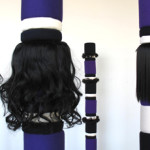Perhaps the most distinct and, ironically, traditional aspects of Nina Lola Bachhuber’s show Yesterday I Ate A Lizard is its insistence on formal strategies. It is surprisingly refreshing to find a sculptor primarily interested in a vocabulary that actually stays within the boundaries of object making and does not make allusions past what is at hand. In this sense, her work gathers meaning almost exclusively from her choices of color, shape, surface, and material.
The majority of Bachhuber’s work rests on familiar forms: Totem-like poles, eggs, bones, furniture and the human figure. Actually, it may be more accurate to say that all of her forms are reconfigured through the human figure creating eerie, and often humorous juxtapositions. For instance, Wintergotzen (Winter Idols) is a set of two curvy objects, human in dimension, but clearly not exclusively derived from the figure. Around their “necks” each object adorns jewelry that accentuates the dyed black calfskin that operates as a skin for these provocative forms. Many of the other pieces in the show employ the same strategy. In Tagesscheu knitted yarn is wrapped around bread-like shapes creating a group of dangling cocoons. This becomes a familiar trope throughout the show, where references to cocoons, eggs and furniture are abundant. Take the group of discreet eggs with long strands of hair poking out that are nestled in a corner, setting the stage for other numerous references to things that produce a body, or are at least a part of one.
While it is tempting to start labeling her “things” as creatures, as an invented breed ready to be hatched, it would be a mistake simply because the “otherness” in her work is never fully represented. Never does her work veer too far away from objectness. In other words, while Tagesscheu may be “like” cocoons, they are still just knitted yarn around a structure. I suppose all of her works are “like” other things, but never are quite “that.” Indeed, Bachhuber’s work seems obsessed in giving details of animal (calfskin, rabbit fur, bones, eggs), the human figure (shape, scale, accessories, hair), and alien (tentacles, exaggerated or distorted human figures) but never giving one a hierarchy over another. She incorporates elements of all of them precisely to stay in that ambiguous category. Perhaps this is what Gregory Volk means when he notes, “how rigorously conceived and rendered [her sculptures]are, how precise, and how acutely focused on formal matters of materials, shape, volume, surface, texture, and color."
In this sense, the work truly operates in-between, which gives validity to Gamaliel Herrera’s reference to the “rhizome” strategy utilized in the work. While Deleuze and Guattari’s strategy to break down polar categories (precisely one of abstraction and figuration in Bachhuber’s work) may be present, the concept of “in-between” put forth by Homi Bhabha is also useful. Bhabha’s in-between is often in reference to the Diaspora experience and accounts for the post-modern confusion of being in one place but never quite being totally a part of that place. However, if this work represents an allegory for the Diaspora experience, it does it with surprising humor and is never dogmatic or overly serious. If one were too replace the surface of Wintergotzen (Winter Idols) with bronze, they would have a slightly enlarged Brancusi. Or, if one were to change the proportions of La femme, la tete, et son amenagement, they might just have a very functional IKEA island. But, this is what one precisely cannot do. To take one element out and replace it with another is simply a formal exercise, one in which Bachhuber has already done.
Links:
Space Other
Deleuze and Guattari's Rhizome
Homi K. Bhabha
"Nina Lola Bachhuber: Yesterday I Ate A Lizard" was on view from April 14th through May 13, 2006 at Space Other.
All images are courtesy of the artist and Space Other.







